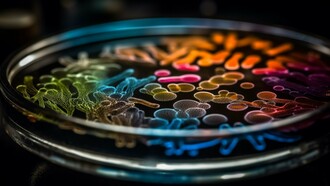The United States Department of Agriculture (USDA) has approved the first vaccine for honey bees (Aphis mellifera). It will prevent American foulbrood disease, a fatal disease that can destroy honey bee colonies that are caused by the gram-positive bacterium Paenibacillus larvae1-5 The bees are not injected with the vaccine. Instead, it is mixed into queen feed, which worker bees consume. The vaccine gets into the royal jelly, which the worker bees feed to the queen bee. Upon eating the jelly, the vaccine is deposited into the queen’s ovaries. Then, the larvae that are born will be immune to the disease. Up to now, the primary treatments have been antibiotics and incinerating infected hives.
Honey bees pollinate both wild and cultivated plants2. They are inexpensive, versatile and convenient for farmers. They are often the only way that pollination can be ensured in environments that have few other pollinators. So, managed honey bee colonies are very important livestock. Sadly, they are threatened by pathogens, neonicotinoid insecticides, increasing atmospheric carbon dioxide and global climate change. There has been a widespread decrease in honey bee populations and a collapse of their colonies. This is called honey bee colony collapse disorder, or CCD6,7.
Honeybees and many other insects have been in decline for decades8-11. This threatens the supply of colonies needed to pollinate fruit, nut and other specialty crops. Honey bee populations declined by 61% between 1947 and 2008 in the USA. Despite colony losses over the last 10 years, the total number of colonies managed in the USA has increased from 2.39 million in 2006, when CCD was first reported, to 2.92 million on Jan 1, 202112 This increase is due to beekeepers replacing dead colonies by splitting existing colonies into two or more smaller colonies. Still, they are threatened by European Foulbrood (EFB) and American Foulbrood (AFB) diseases3. These were the most important diseases affecting honey bees before the arrival of the parasitic mite, Varroa destructor. AFB not only kills infected larvae. It is highly contagious, being spread by exchanging hive and bee material between colonies. In many countries, AFB is a notifiable disease. So, laws may force contaminated colonies to be burned. AFB is a serious threat to honey bees throughout the world3.
The gram-positive bacterium P. larvae produce endospores that infect larvae mostly between 12 to 36 hours after fertilization3. After being eaten, the spores pass through the larval foregut and germinate in the larval midgut around 12 hours later. Vegetative bacteria colonize the midgut, reproduce and live off the food ingested by the honey bee larvae. Infected larvae die and are degraded into something that has been called a ropy mass that looks like rope. In addition, a foul smell is produced3. The spores can last for decades in the environment, staying virulent the entire duration, and thus posing a continuous threat to honey bee colonies2.
Honey bees are not helpless, but they are different. Like other insects, they don’t produce antibodies. Still, they are capable of trans-generational immune priming (TGIP) to protect their offspring from pathogens. They are able to display immunity against infectious diseases to which they have been previously exposed. TGIP is similar to the adaptive immune systems in vertebrates, but the way this happens is poorly understood. Fortunately, we do know that information about P. larvae can be transferred to the next generation with the help of the egg yolk protein vitellogenin and pieces of the bacteria. So, a vaccine was developed that contained a bacterin, or proprietary aqueous suspension of inactivated P. larvae vegetative stage bacilli. The bacterin was blended with queen feed. The queens were vaccinated with either bacterin or placebo for 8 days. Vaccinated and placebo queens were released into hives. After at least 18 days post hive placement, frames with 0 - 36 hour-old brood were brought to the laboratory for challenge testing with an aqueous suspension of spores. The vaccinated bees had nearly 50% higher disease resistance than the placebo group2.
This led the USDA to approve this vaccine, Hopefully, it will prevent the widespread death of honey bees caused by AFB.
Notes
1 Sottile, Z. The first-ever vaccine for honeybees has been approved by the USDA. CNN, 7 Jan., 2023.
2 Dickle, F. et al. The oral vaccination with Paenibacillus larvae bacteria can decrease susceptibility to American Foulbrood infection in honey bees - a safety and efficacy study. Frontiers in Veterinary Science 17 Oct., 2022.
3 Genersch, E. American Foulbrood in honeybees and its causative agent, Paenibacillus larvae. Journal of Invertebrate Pathology. Volume 103, p. S10–S19, 2010.
4 Daisley, B.A. et al. Disentangling the microbial ecological factors impacting honey bee susceptibility to Paenibacillus larvae infection. Trends in Microbiology. 24 Dec., 2022.
5 Grady, E.N. et al. Current knowledge and perspectives of Paenibacillus: a review. Microbial Cell Factories. Volume 15, article 203, 2016.
6 Banaji, S. Colony collapse disorder, neonicotinoids, CO2, climate change, and the four spheres. Open Journal of Ecology. Volume 12, p. 711-717, 2022.
7 Nikita, et al. Colony collapse disorder: A peril to apiculture. Journal of Applied and Natural Science. Volume 14, p. 729 – 739, 2022.
8 Kuhlhanek, K. et al. A national survey of managed honey bee 2015–2016 annual colony losses in the USA. Journal of Agricultural Research. Volume 56, 2017.
9 Balvino-Olivera, F.J. et al. Long-term spatiotemporal patterns in the number of colonies and honey production in Mexico. Scientific Reports. Volume 13, article 1017, 2023.
10 Wagner, D.L. et al. Insect decline in the Anthropocene: Death by a thousand cuts. PNAS. Volume 118, article e2023989118.
11 Yang, Y. et al. Global honeybee health decline factors and potential conservation techniques. Food Safety. 2023.
12 United States Department of Agriculture, National Agricultural Statistics Service, Honey bee colonies. 2021.















